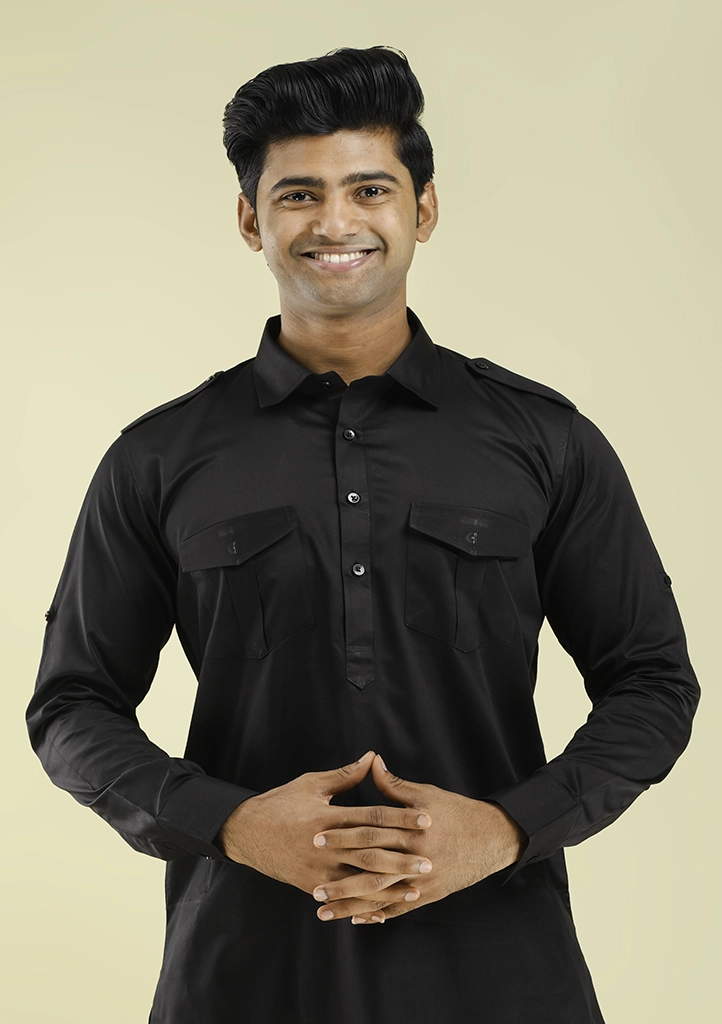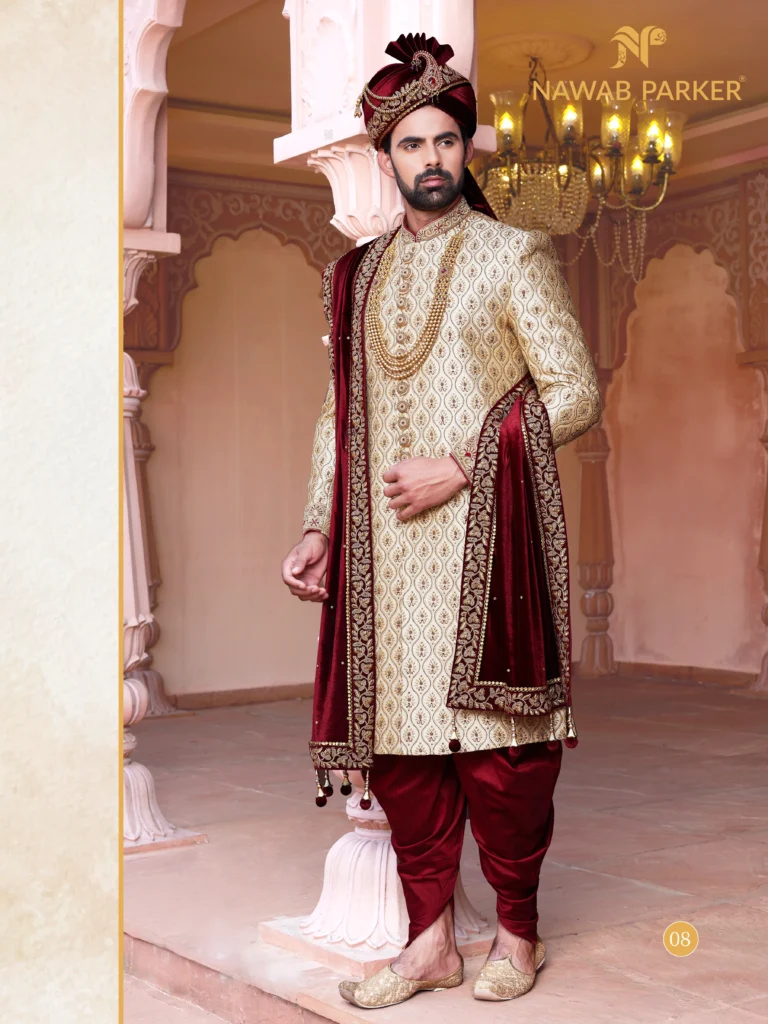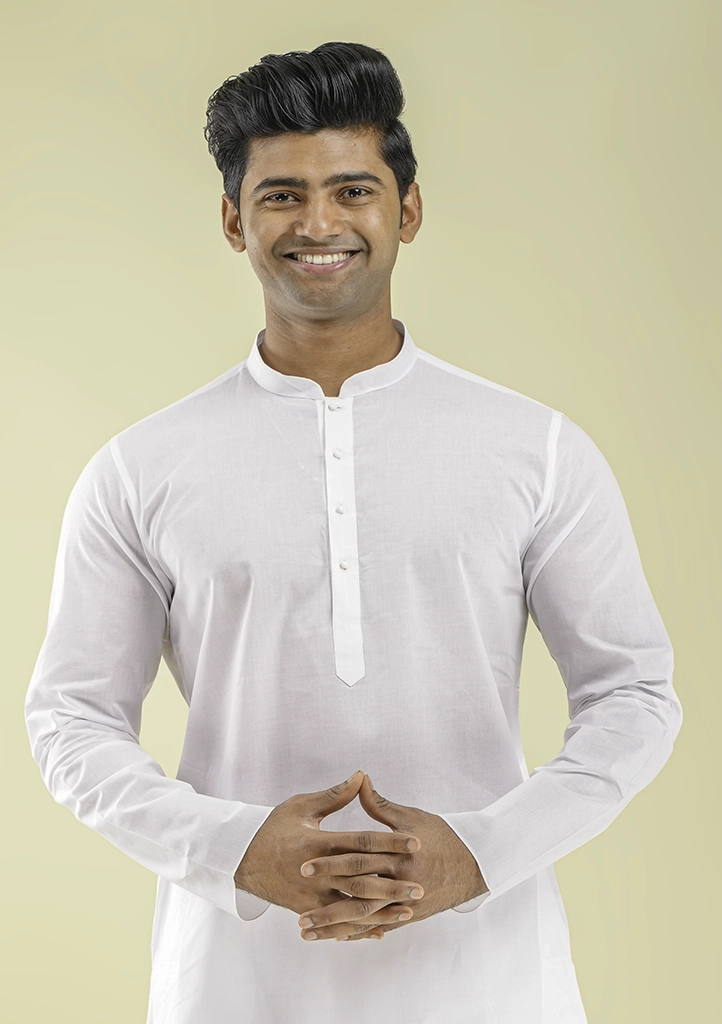When it comes to clothing, especially in the Indian context, there's an entire world beyond suits and jeans. We often find ourselves toggling between formal office wear and casual western clothes, but when there's a wedding, a religious function, or a cultural gathering, what then? That's when tradition doesn't just walk in, it demands a seat at the table.
As men, we're frequently guilty of neglecting ethnic wear in our wardrobes until the last moment. Let's not do that anymore. Let's talk essentials. Here's our breakdown of five traditional outfits we believe every Indian man should have in his closet, not for fashion's sake alone, but because occasions arise, and when they do, we'd rather not be borrowing kurtas from cousins who are one size too small.
1. The Pathani Kurta Pajama

Let's begin with something that has managed to hold its ground in every decade, without bending to trends or gimmicks, the Pathani kurta pajama.
This is not your average kurta. Structurally, it's different. The Pathani has a shirt-like silhouette with cuffed sleeves, a straight hem, and often includes side slits and a defined collar. It carries a certain masculinity that's rooted in its military-like styling, unsurprising, considering its cultural origins in the North-West Frontier regions.
In our experience, the Pathani works best for Eid gatherings, post-sunset functions, and even engagement ceremonies where the vibe is laid-back yet traditional. It gives off a sense of balance: not too laidback, not too ceremonial.
Now, to get it right, attention needs to be given to fabric and fit. Cotton variants lean more into everyday or casual-wear territory, while silk blends and linen-cotton mixes can be elevated for semi-formal events. Darker shades, deep navy, charcoal, bottle green, tend to look sharper in this style.
We've written a full breakdown of how to wear, style, and select the right Pathani suit for various settings here. It's worth going through if you're unsure how to make this outfit work across different settings.
2. The Classic Sherwani

No surprises here. The sherwani remains a powerhouse in Indian menswear. But let's be honest, how many of us actually own one?
It's the outfit we rent. The one that gets worn on the friend's wedding day and returned before breakfast the next day. But if you're getting married, or if you're the brother of the groom, owning a sherwani makes a lot more sense.
The key is to invest in a sherwani that has longevity. Avoid prints or too much embellishment unless you know you're the type to embrace maximalism. Look for handwoven fabrics, raw silk, tussar, or even velvet if you have the frame for it. Neutral tones with subtle embroidery age better than bold trends that scream a particular year.
A well-structured sherwani, paired with churidar pants or straight-cut trousers, and worn with a safa or stole when needed, can carry you through multiple events across the wedding season.
We don't wear it often, sure. But when the need arises, nothing else quite fits the bill.
3. The Nehru Jacket Ensemble
Ah yes, the one piece that managed to transition from political symbolism into cocktail party wear.
The Nehru jacket is wildly versatile, but that doesn't mean it suits every outfit combination you throw at it. We've seen it worn over t-shirts, which might be fine for college events, but we're not going to recommend that here.
Instead, think of it as an ethnic blazer. Pair it over a crisp kurta-pajama set or even a band-collar shirt and chinos. It works for semi-formal Diwali gatherings, intimate weddings, and even networking events that call for a fusion wardrobe.
What to look for? Avoid synthetic sheen. Instead, go for textures, tweed, khadi, jacquard silk. The fit should be tailored. It's not supposed to feel like outerwear. It should hug the shoulders and cinch slightly at the waist.
And one more thing: pocket squares matter.
4. The Dhoti-Kurta (or Veshti/ Mundu Set)
Now, this one comes with regional nuance.
Depending on where you're from, the dhoti will take a different name, veshti in Tamil Nadu, mundu in Kerala, panche in Karnataka. Whatever you call it, the format remains similar: a draped lower garment, paired with a long kurta or angavastram.
This isn't something you wear because it's trending on Instagram. It's a garment steeped in ritual and cultural specificity. We see it mostly during temple ceremonies, religious functions, and regional festivals.
Mastering the drape takes some practice, there's no shortcut. If you're new to it, there are pre-stitched versions available that don't compromise on authenticity.
Pair it with a long-sleeved cotton kurta or a linen angavastram-style wrap. Footwear should be traditional: kolhapuris or mojaris. And avoid sunglasses indoors, we're begging you.
5. The Casual Kurta-Pajama (For Real-Life Use)

Now, we can't talk about ethnic wear without addressing the everyday kurta-pajama. The one that doesn't scream, the one that doesn't try too hard.
This is the piece you throw on for casual dinners, day-time pujas, or even brunches when the invite says “ethnic light.”
The trick here is to get a few kurtas in pastel tones, fine cotton or linen, and mix them up with different lowers, white churidars, darker pajama bottoms, even denims if the setting calls for it.
If you're the kind who attends more than three cultural functions a year, keep two to three of these in rotation. Vary the lengths, cuts, and collars to keep things interesting.
And yes, while we all have that one maroon kurta from a Diwali five years ago, it's time we retire it. You know the one.
What's the Right Order to Invest in These?
That depends on your calendar. If you're in your 20s and attend more haldi functions than board meetings, start with a Pathani and a couple of casual kurtas. A Nehru jacket next. If your own wedding is on the horizon, or even a sibling's, put the sherwani on priority.
Regional customs matter too. If your family celebrates Onam, Pongal, or any temple-based rituals, owning a dhoti set becomes less optional and more practical.
It's not about checking boxes. It's about being ready without being reactive.
Final Word
Let's not pretend ethnic wear is part of our daily rotation. But the moment we need it, we remember how unprepared we were the last time. The wrong fit, the borrowed look, the missed dry-cleaning.
Let's avoid that going forward.
One piece at a time. Build a collection. Keep it authentic. Don't chase what's loud, go for what suits your build, your tone, and your regional roots.
We've done the homework on one of the most underappreciated pieces in that mix, the Pathani Kurta Pajama. You'll find everything about it here, from historical context to pairing strategies and fit breakdowns.
That's a solid place to start.
Frequently Asked Questions (FAQ)
Q1. Do I really need all five outfits in my wardrobe?
Not necessarily. Start with what fits your personal calendar and cultural context. If you attend a lot of weddings, invest in a sherwani or Nehru jacket early. If your ethnic wear use is more festival-based, a couple of well-fitting kurtas and a Pathani might be enough to start with.
Q2. Can a Pathani kurta be worn to formal events like weddings?
Yes, but with caveats. Stick to richer fabrics, like blended silks or textured cotton, and pair them with sharp bottoms and traditional footwear. Avoid printed or overly casual Pathanis if the setting demands more polish. Full guide here.
Q3. How is a Pathani different from a regular kurta-pajama?
The main difference lies in the construction. A Pathani kurta has a collared, shirt-like design with full sleeves and often pockets. It's cut straighter, tends to be slightly longer, and is often paired with salwars or straight-cut pajamas. Regular kurtas are softer in structure and more flowy.
Q4. Is the Nehru jacket still in fashion?
It hasn't gone anywhere. The key is to wear it correctly, don't toss it over a t-shirt and jeans and expect it to work. Pair it with ethnic base layers, well-fitted pants, and solid footwear. The simpler the design, the more events it fits into.
Q5. I've never worn a dhoti—should I still own one?
Depends on your region, rituals, and confidence. If your family follows South Indian or Bengali customs, owning at least one dhoti (or veshti/mundu) makes sense. If you're not confident with the drape, consider pre-stitched variants, they're widely available and look close enough.
Q6. Can ethnic wear be reused across different occasions?
Absolutely, but plan with intent. Stick to versatile pieces and neutral tones. A plain kurta can be restyled with different jackets. A sherwani, if chosen well, doesn't need to be one-and-done. Rotation isn't about repetition, it's about smart pairing.
Q7. Where can I find good quality Pathani kurtas or sherwanis online?
You can browse curated ethnic wear, including Pathani sets, sherwanis, and wedding attire at nawabparker.com. Everything is designed and made in-house, with a focus on cultural fit and garment consistency.






